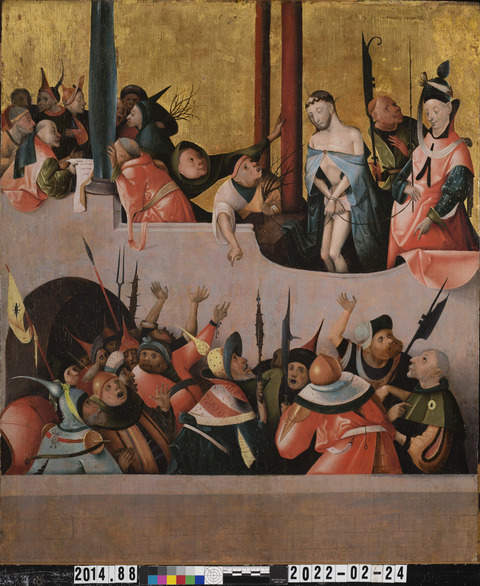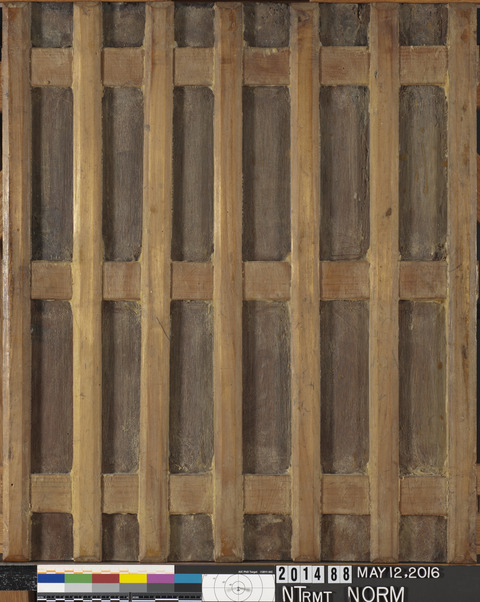Overview
Identification number: 2014.88
Artist: Follower of Hieronymus Bosch
Title: Ecce Homo
Materials: Oil and gilding on oak panel
Date of creation: After 1504
Previous number/accession number: C10006
Dimensions: 61.5 × 52 cm
Conservator/examiner: Roxane Sperber with contributions from Erica Schuler
Examination completed: 2016, revised 2022
Distinguishing Marks
Front:
None
Back:
None
Summary of Treatment History
Physical evidence on the painting suggests a long history of structural and aesthetic interventions prior to work’s arrival at the Indianapolis Museum of Art (IMA) on permanent loan in 1971. The painting underwent extensive structural treatment to correct insecurities within the picture layer and support. The panel was thinned, and a ten-member cradle was attached to its back. The back was covered in a thin wax moisture barrier. The paint layer shows needle holes where a consolidating agent was injected by syringe to stabilize flaking within the paint and ground layers. Additionally, retouching and ingilding, present on the painting until the most recent treatment, provide further evidence of past aesthetic intervention.
Documentation suggests a series of condition assessments and treatments were carried out on the collection around the time the works were moved from the Clowes' residence to the IMA in 1971. A condition report by Paul Spheeris in October of that year, likely carried out before the paintings were relocated, described the painting as “O.K.” but having some cleavage in the bottom right. He recommended cleaning for the sake of the work’s appearance but not for its safety.1 A second condition assessment was carried out upon arrival of the paintings at the IMA, and minor structural stabilization of the cleaving paint was completed using wax.2
In 1994, dendrochronological analysis was performed in the IMA Conservation Laboratory by Peter Klein in collaboration with IMA staff. His results confirm a plausible creation of the panel after 1504.
Consolidation of lifting paint in an area of old fill material was carried out along the left side of the composition in 2016. The painting underwent full treatment in 2021. A matte beeswax surface coating was identified on the painting prior to the treatment,3 and this treatment involved the removal of the beeswax and natural resin varnish coatings. The treatment also removed old fills, retouching, and overpaint. A new varnish layer was applied and inpainting and ingilding areas of loss was carried out.4
The condition of the painting was recorded in the Clowes Collection annual survey from 2011 to 2021.
Current Condition Summary
Following the 2021 treatment, the painting is in good structural and aesthetic condition. The panel is held in plane by a cradle attached to the back. The wax coating on the back provides a barrier from environmental fluctuation. Incipient lifting of fill material noted during the 2016 examination was secured through consolidation and has continued to be stable. Some insecure areas of fill were removed and replaced during the 2021 treatment. Poorly matched areas of gilding were removed and new ingilding was applied to provide a more unified aesthetic to the painting.
Methods of Examination, Imaging and Analysis
| Examination/Imaging | Analysis (no sample required) | Analysis (sample required) |
|---|---|---|
| Unaided eye | Dendrochronology | Microchemical analysis |
| Optical microscopy | Wood identification | Fiber ID |
| Incident light | Microchemical analysis | Cross-section sampling |
| Raking light | Thread count analysis | Dispersed pigment sample |
| Reflected/specular light | X-ray fluorescence spectroscopy (XRF) | Fourier-transform infrared spectroscopy (FTIR) |
| Transmitted light | Macro X-ray fluorescence scanning (MA-XRF) | Raman microspectroscopy |
| Ultraviolet-induced visible fluorescence (UV) | ||
| Infrared reflectography (IRR) | Gas chromatography–mass spectrometry (GC-MS) | |
| Infrared transmittography (IRT) | Scanning electron microscope -energy dispersive X-ray spectroscopy (SEM-EDS) | |
| Infrared luminescence | Other: | |
| X-radiography |
Technical Examination
Description of Support
Analyzed Observed
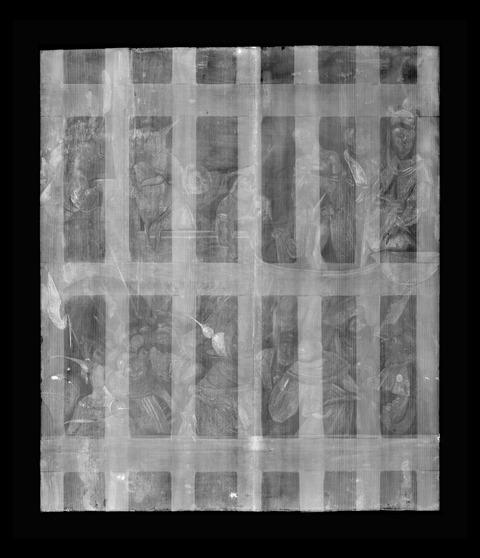
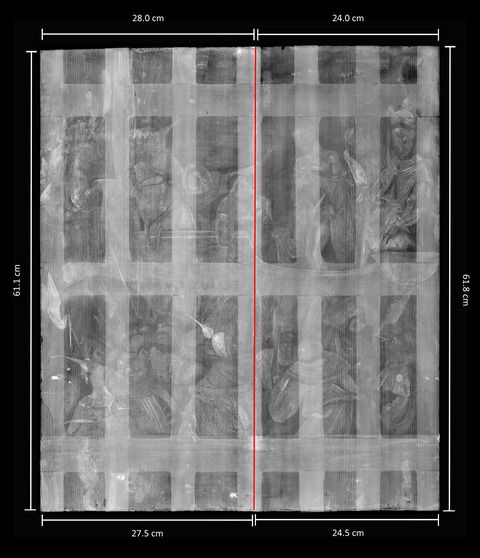
Material Type (fabric, wood, metal, dendrochronology results, fiber ID information, etc.):
The painting is executed on a wood support composed of two vertically grained oak boards, which were analyzed and dated by Peter Klein in 1994. Klein deemed the outermost heartwood of the oak to date to 1479 and the earliest felling date to be 1488. Klein suggested that, with a minimum of two years for seasoning the wood, the earliest creation date for the painting is 1490 but most likely dates closer to after 1504.5
Characteristics of Construction/Fabrication (cusping, beveled edges of panels, seams or joins, battens):
The panels were thinned during a past stabilization campaign in preparation for the attachment of an auxiliary wood cradle and subsequently coated in a thick layer of wax. The original joinery does not appear to have been preserved. At present, the boards are butt-joined, and the join is bridged with an adhered vertical cradle member (fourth from proper right) (tech. fig.1).
Thickness (for panels or boards):
The panel no longer retains its original thickness and was uniformly thinned to approximately 0.5 cm during a past stabilization campaign.
Production/Dealer’s marks:
No production or dealer’s marks were observed.
Auxiliary Support:
Original Not original Not able to discern None
A ten-member wood cradle is attached to the back of the panel: seven vertical members, glued into a fixed position following the wood grain, are perpendicularly interlaced by three horizontal sliding members to form a full lattice support. The beveled vertical battens measure 61.2 × 3 × 1 cm and the horizontal battens measure 4.4 × 52.4 × 0.7 cm. The back of the thinned panel and auxiliary cradle are coated in a thick barrier of brush-applied wax resin.
Condition of Support

The thinned panel is currently in stable condition and held in plane by the cradle. Originally constructed with movable horizontal members, the cradle is now immobile, fixed by an uneven coat of brush-applied wax resin. The barrier covers the entire back and serves to protect the hygroscopic wood from reacting with moisture and extreme fluctuations in relative humidity—conditions which likely contributed to extensive past instability and damage noted not only within the support but in the ground and paint layers as well. Minor surface distortion is present around the join between the two planks (tech. fig. 2). The crack extends from the top to the bottom edge and, having been repaired and structurally reinforced during the attachment of the auxiliary support, is stable. The fixed rigidity of the cradle will not adversely affect the support/painting as long as the artwork remains within a controlled environment and the temperature and relative humidity are continually monitored.
Description of Ground
Analyzed Observed
Materials/Binding Medium:
Analysis of cross section 3 (tech. fig. 3) from an area of gilding, before the 2021 treatment, was analyzed using SEM/EDS. The ground was found to be rich in calcium, but did not contain sulfur, suggesting the use of calcium carbonate (tech. fig. 5). A coccolith can be seen in the upper left portion of the ground (tech. fig. 4) confirming the use of calcium carbonate. This is consistent with other paintings of Northern European origin.
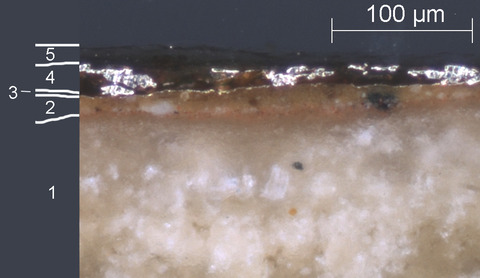
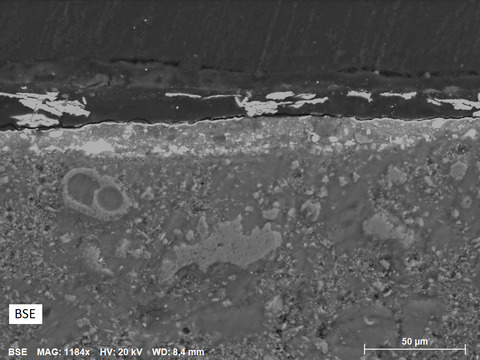
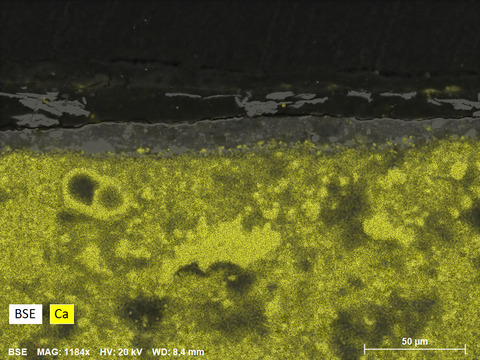
A thin, lead-white-containing imprimatura applied directly on top of the ground can be observed using microscopy under the painted areas of the composition. In some areas, this layer looks white, and in others it appears to have a brownish-red hue. Under the areas of gilding, a darker red paint layer appears to function as a bole (tech. fig. 3, layer 2). SEM/ EDS analysis of this layer detected the presence of iron and aluminum as well as a considerable amount of lead, suggesting the mixture of iron-rich aluminum silicates with lead white (see tech. figs. 11, 12).
Color:
Exposed ground that is visible in the losses and around the periphery appears off-white in color and is covered by a slightly warm imprimatura that in some areas appears brownish red.
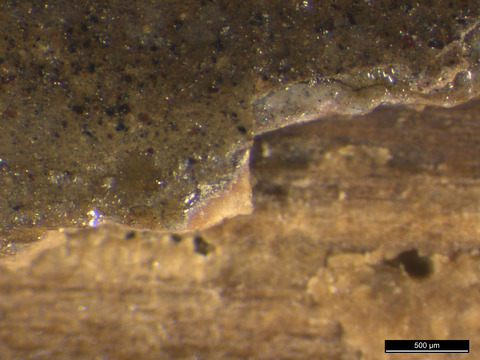
Application:
When observed under low-power magnification and in cross section, the ground appears as a single, relatively thick layer that was likely brushed directly on the sized panel. Once dry, the surface was smoothed to achieve a uniform surface free of any irregularities related to the wood panel. The imprimatura and bole layers were applied over the off-white ground.
Thickness:
The ground is relatively thick (approximately 100 µm), and the surface appears smooth under normal viewing conditions, yet the vertical wood grain can be detected under strong raking light. The imprimatura layer appears thin but consistent across the panel.
Sizing:
A sizing layer cannot be discerned with the naked eye or in cross section. However, the panel was likely prepared with several layers of animal glue before the ground was applied.
Character and Appearance (Does texture of support remain detectable/prominent?):
The ground appears relatively thick and smooth under normal viewing conditions; however, the vertical wood grain can be detected under extreme raking light conditions.
Condition of Ground
The condition of the ground is in stable condition although there are significant losses to the ground and paint layer (see tech. fig. 30). There is a pronounced pattern of age-related craquelure, showing jagged and straight-edged cracks forming square islands, extends through both the ground and paint layers overall.
Evidence of multiple filling and retouching campaigns indicates that adhesion between the ground and support as well as the ground and paint layer has been a recurring problem throughout the painting’s history. Extreme raking light shows pronounced surface distortions from past lifting, cleavage, and tenting within passages of damaged original material and in aged restoration materials Although present overall, old losses appear to be concentrated within the proper right panel and along the painting’s bottom edge, which may relate to extended exposure to moisture in the past. Active and incipient flaking of deteriorating restoration fill material was treated during a 2016 examination, and stable environmental controls have prevented the issue from returning.
Description of Composition Planning
Methods of Analysis:
Surface observation (unaided or with magnification)
Infrared reflectography (IRR)
X-radiography
Analysis Parameters:
| X-radiography equipment | GE Inspection Technologies Type: ERESCO 200MFR 3.1, Tube S/N: MIR 201E 58-2812, EN 12543: 1.0mm, Filter: 0.8mm Be + 2mm Al |
|---|---|
| KV: | 24 |
| mA: | 3 |
| Exposure time (s) | 60 |
| Distance from x-ray tube: | 36” |
| IRR equipment and wavelength | Opus Instruments Osiris A1 infrared camera with InGaAs array detector operating at a wavelength of 0.9-1.7µm. |
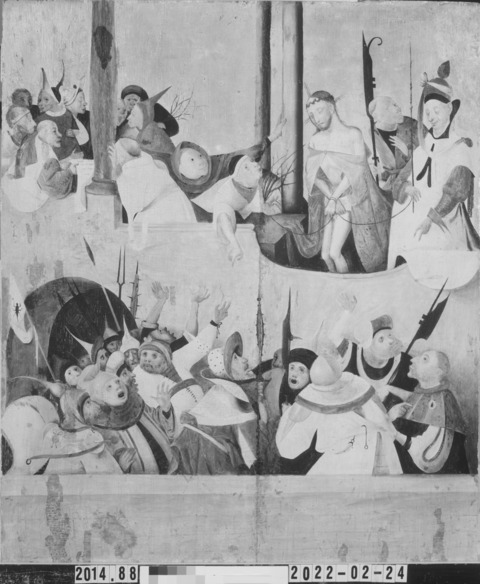
Medium/Technique:
The composition was likely planned in detail through preliminary sketches as no evidence of adjustments to the composition was observed when comparing the visible composition with the X-radiograph and infrared photograph (tech. fig. 6). Clear underdrawing was not observed using infrared photography, however, close examination of the infrared reflectogram, from before the 2021 treatment, reveals subtle fine lines executed in what appears to be a dry carbon-based medium in addition to shading in wet medium throughout the composition (tech. figs. 7). These observations suggest that an outline was drawn on the ground, either before or after the imprimatura was applied, to delineate the contours of the figures, drapery, and architecture.
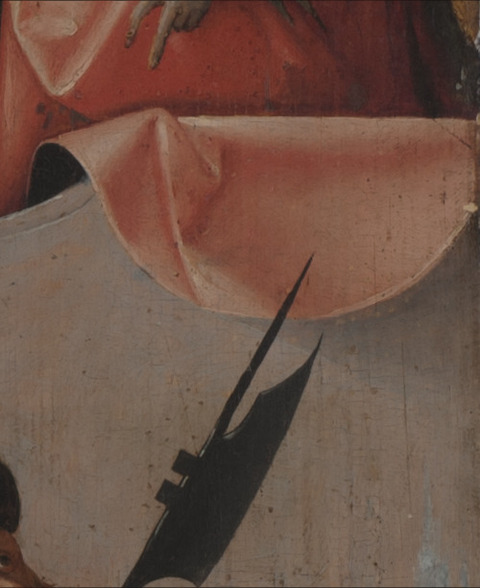
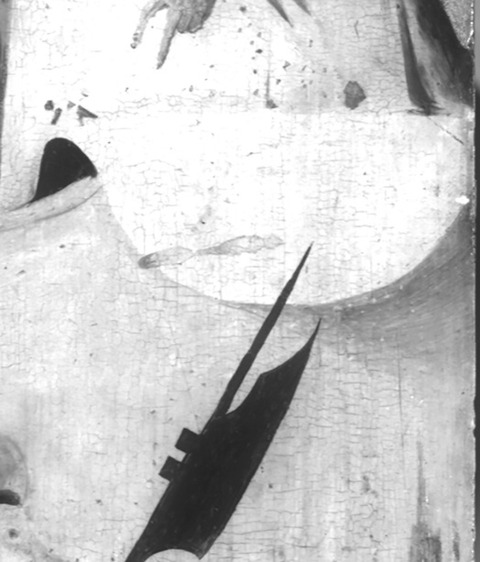
Pentimenti:
No pentimenti or changes to the composition were noted.
Description of Paint
Analyzed Observed
Application and Technique:
Gilding:
After establishing the composition, the artist applied gold leaf to the background following the contours intended for the painted design. There is no evidence of incision lines around the painted composition, and in some areas the paint extends over the gilding (tech. fig. 8).
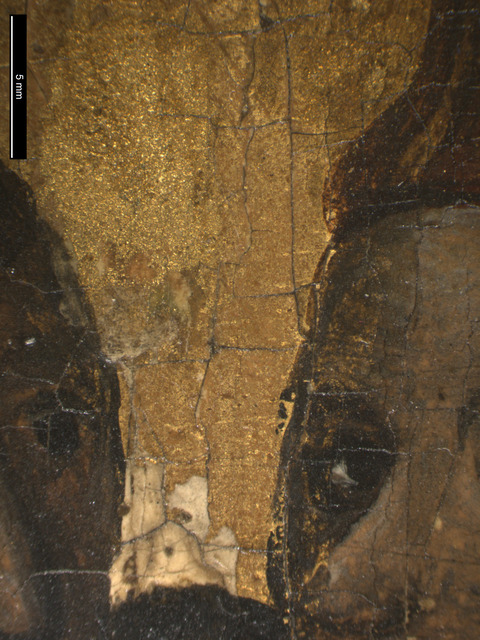
A reddish-brown imprimatura was applied under the gilding (tech. fig. 9). This imprimatura visually functions as a bole but does not have the thickness and opacity of a traditional clay bole. EDS analysis of the imprimatura and gilding found that while the imprimatura does contain iron (tech. fig. 11, orange), aluminum, and silicon, there is also a considerable amount of lead (tech. fig. 12, blue) present, likely in the form of lead white. The pure gold original gilding is visible in technical figure 13 (purple).
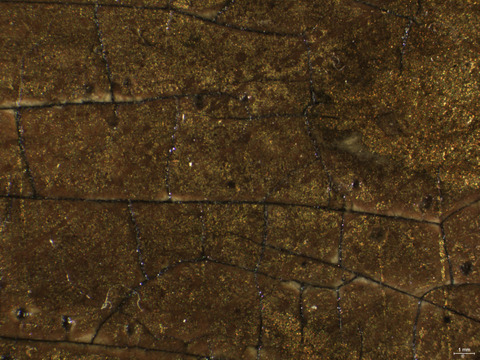
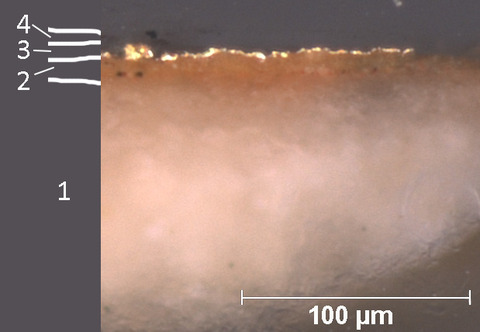
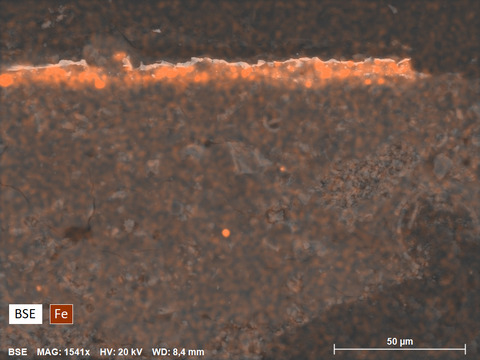
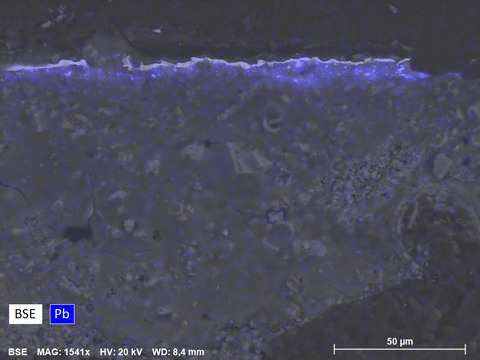
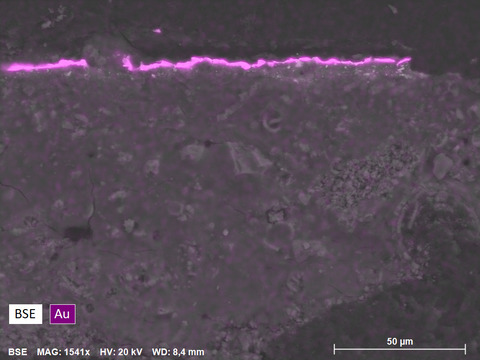
Paint layer:
Visual evidence suggests that the artist outlined forms and introduced shading with a thin, monochromatic underpainting before applying upper layers of paint. The paint was applied systematically despite the complexity of the composition. The paint ranges from a paste vehicular to rich vehicular structure with coarse pigment particles visible under magnification and is applied in short, fine, linear brushstrokes (tech. fig. 14).6
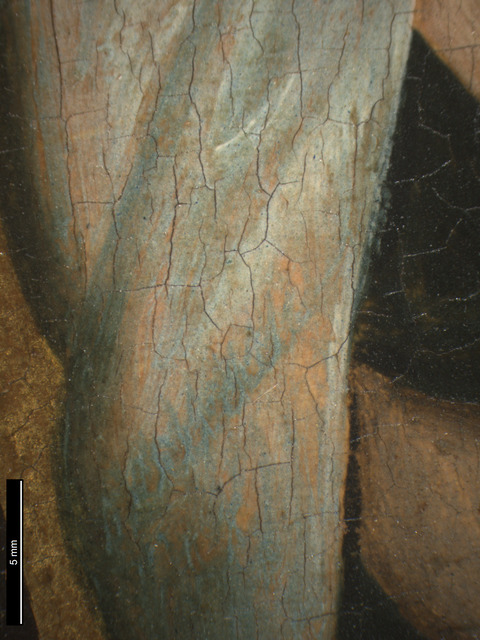
The figures were painted first with the background wall and balustrade painted in around them (tech. fig. 15).
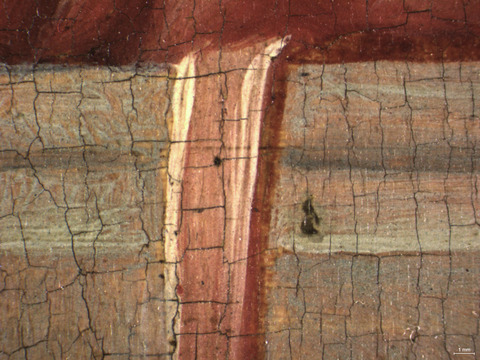
Midtones were blocked in to fill the shape of each designated area of color, leaving a small gap between blocks of color in some areas (tech. figs. 16, 17).
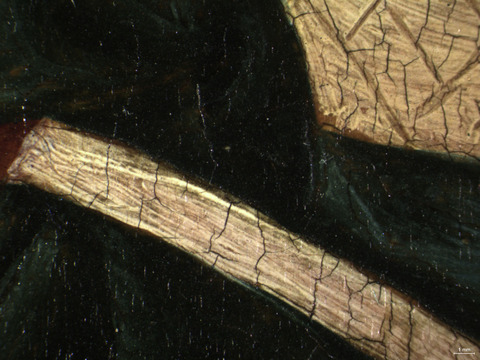
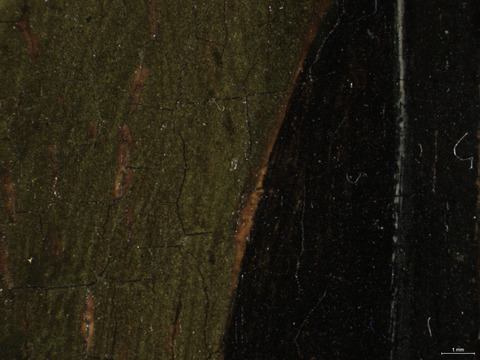
Highlights were mixed from the midtone with the addition of lead white and/or lead-tin yellow. Glazed shadows were applied in the reds, greens, and blues. The faces were painted in varying tones from ruddy reds and browns to pale pinks and grays. Expressive outlining was applied last to create the individualized expressions on the faces (tech. fig. 18) and delineate the hands. Some small details were added over completed drapery, and the underlying layer of paint can be observed through abrasion in the paint layers (tech. fig. 19).
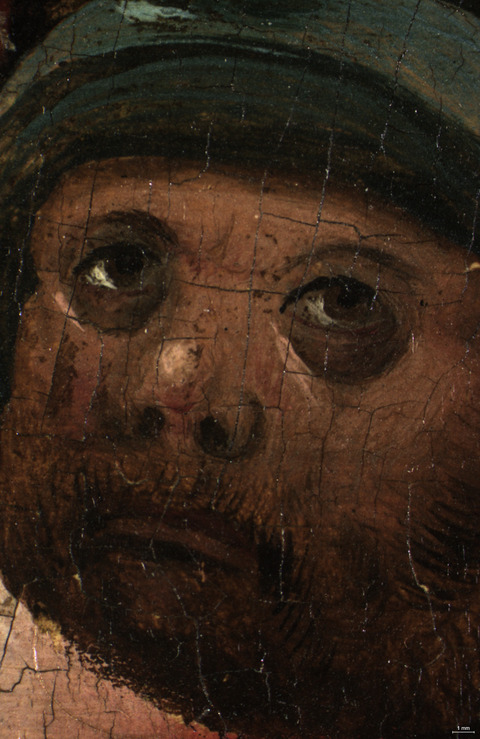
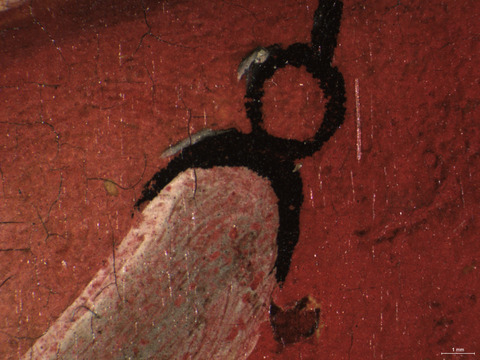
The paint layer is generally quite thin and translucent, showing the underlying ground in some areas as demonstrated in technical figure 14.
Painting Tools:
The paint was applied with small, fine-tipped hair brushes.
Binding Media:
Visual characteristics of the paint indicate that the binding media is oil.
MA-XRF Analysis:
MA-XRF analysis suggests the presence of gold leaf in addition to iron-oxide earth pigments, lead white, vermilion, red lake pigments, smalt, and copper-containing green and/or blue pigments (verdigris and/or azurite) in the palette of the artist.
Distribution of cobalt (blue), nickle (pink), potassium (olive green) suggests the presence of smalt in the areas of blue paint (tech. figs. 20–22). Copper (dark green) was also detected suggesting the presence of verdigris and/or azurite in these areas (tech. fig. 23).
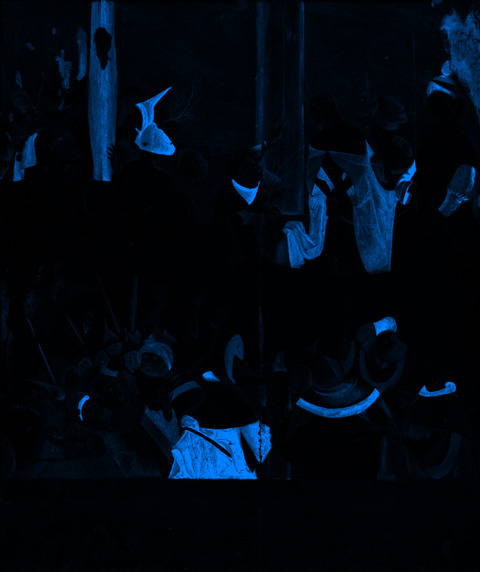
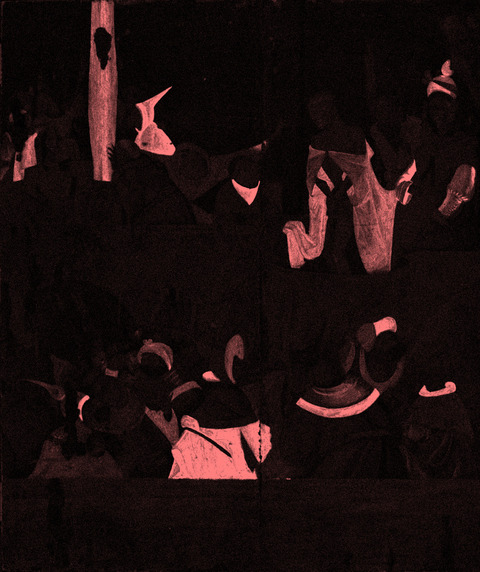
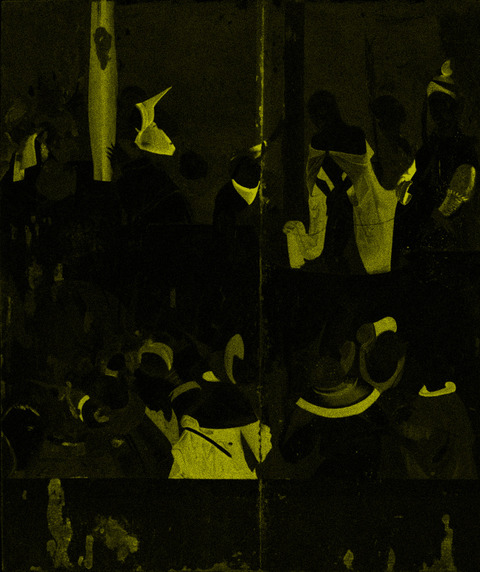
An overlay of copper and cobalt (tech. fig. 23) shows areas of green where no smalt is present as well as areas of dark blue where cobalt and copper appear to have been mixed. It appears that all ares of blue paint have some copper-containing pigments mixed with the smalt. Some areas of light blue, such as the figure on the lower left, do not appear to contain smalt, suggesting a light blue azurite pigment was used.
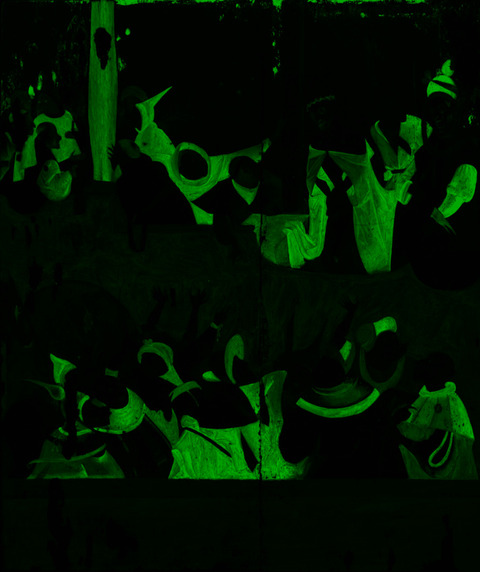

Distribution of lead (blue), tin (light yellow), mercury (red), and iron (orange) shows the likely presence of lead white, lead-tin yellow, vermilion, and iron oxide (earth pigments) (tech. figs. 24-27).
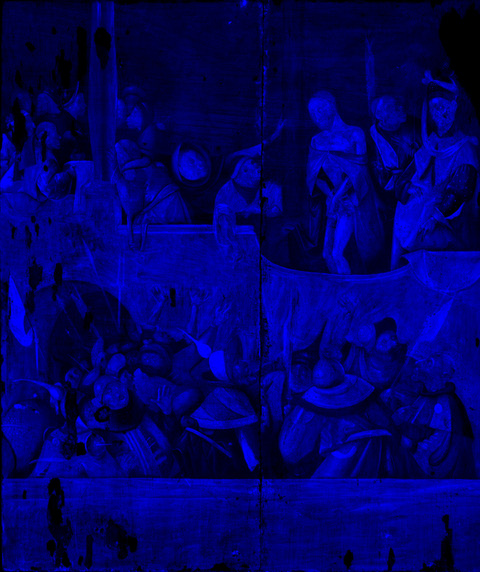
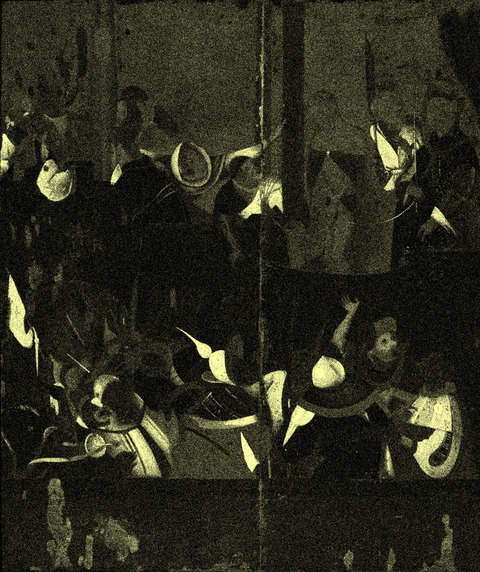
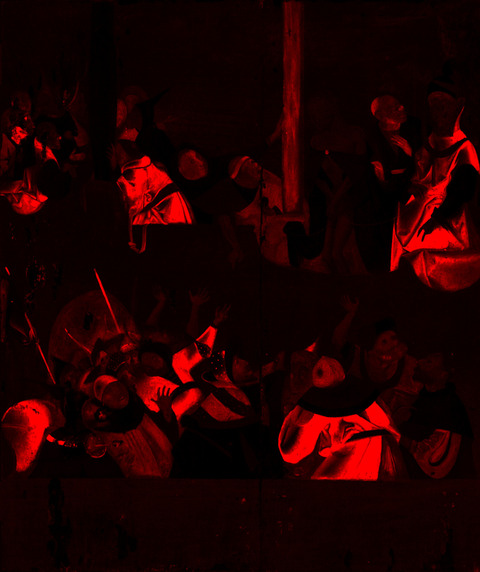
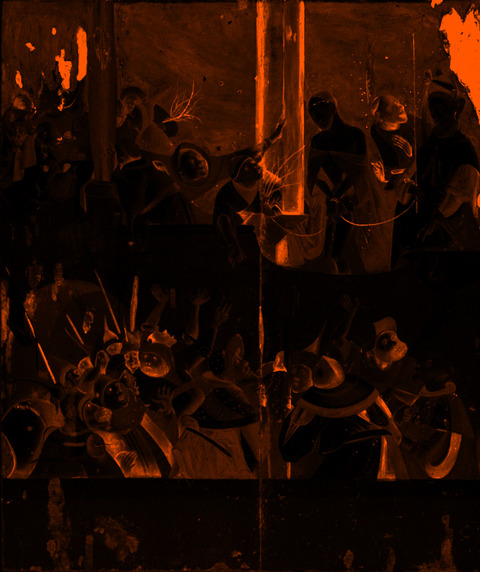
The distribution of manganese (dark red, tech. fig. 28) shows areas of umber-containing pigments used mostly (in the original paint layer) for detailing but also used in the inpainting along the panel join. The distribution of titanium (mint green, tech. fig. 29) also corresponds to areas of loss and corresponding inpainting.
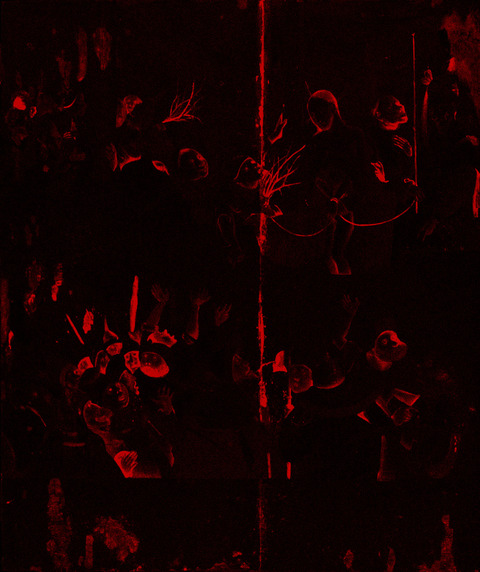
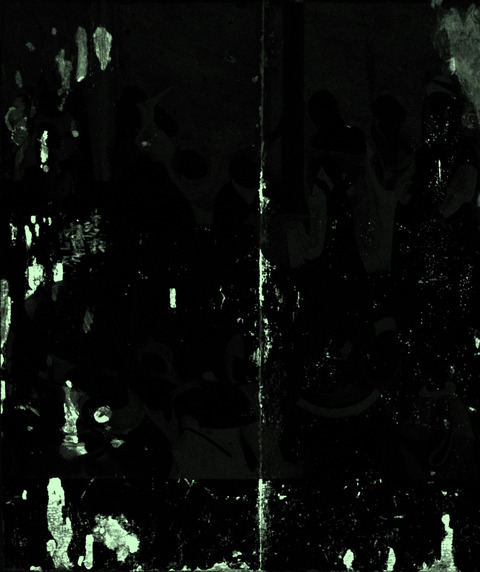
Surface Appearance:
At normal viewing distance and under visible light, the surface of the painting appears smooth with no apparent impasto. The paint is applied in fine, linear brushstrokes that, due to increased transparency of the paint film as it aged and possible solvent abrasion from past treatment campaigns, show the underlying imprimatura and ground beneath the thinnest painted passages (see tech. fig. 14).
Condition of Paint and Gilding
Following the 2021 treatment, the paint layer and gilding are in good condition. The picture layer has sustained numerous past damages related to natural aging and poor environmental conditions. Needle holes related to past consolidation campaigns are present throughout. Losses were filled (tech. fig. 30) and inpainted during the 2021 treatment.
Large areas of gilding have been also been lost, as can be clearly observed in during treatment image (tech. fig. 30).
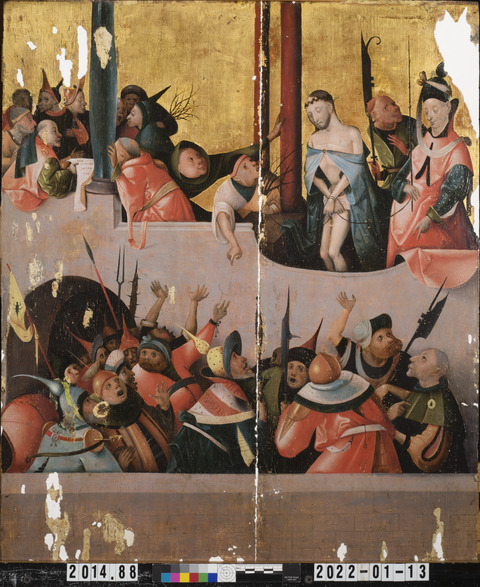
Description of Varnish/Surface Coating
Analyzed Observed Documented
| Type of Varnish | Application |
|---|---|
| Natural resin | Spray applied |
| Synthetic resin/other | Brush applied |
| Multiple Layers observed | Undetermined |
| No coating detected |
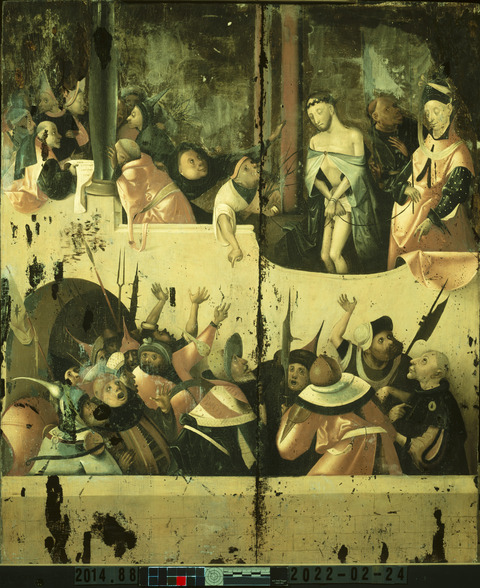
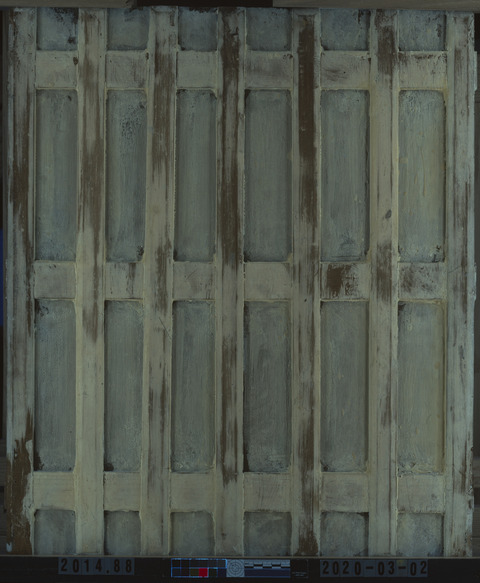
Description of Varnish/Surface Coating:
A saturating brush varnish composed of 80% Paraloid B72 (20% in Shellsol A100) and 20% Laropal A81 (25% in Shellsol A100) was applied with a brush. Inpainting areas of loss was carried out in Gamblin Conservation Colors in 30% Laropal A81.
Over the isolating varnish, a “bole” composed of Golden Acrylic colors to precisely match the slightly atypical original bole was applied over fills in the losses to the gilding. One hour drying oil was applied and gilded with a 23-karat gold leaf. The gold leaf was distressed to mimic the highly distressed pattern of the original gilding. The gilding was then toned first using the 80% Paraloid B72 (20% in Shellsol A100) and 20% Laropal A81 (25% in Shellsol A100) mixed with a yellow woodstain. Because of the highly variable surface of the gilding, several more layers of Gamblin Conservation Colors in 30% Laropal A81 in Shellsol A100 were applied to create some undulation in tone.
A final spray varnish coating of 25% Laropal A81 in Shellsol A100 was applied to saturate the ingilding and inpainting.
The highly fluorescent beeswax coating (tech. fig. 32) remains on the back of the panel as it does not appear to be impacting the structural stability of the panel, and it provides a hydrophilic coating on the wood.
Condition of Varnish/Surface Coating:
Following the 2021 treatment, the varnish is clear and well saturating, and the inpainting and ingilding are well matched.
Description of Frame
Original/first frame
Period frame
Authenticity cannot be determined at this time/ further art historical research necessary
Reproduction frame (fabricated in the style of)
Replica frame (copy of an existing period frame)
Modern frame
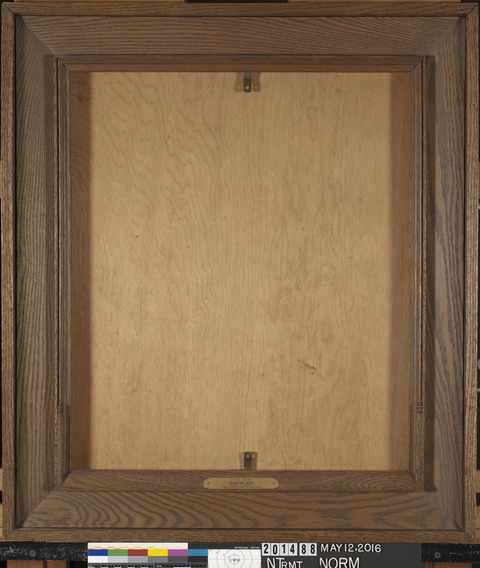
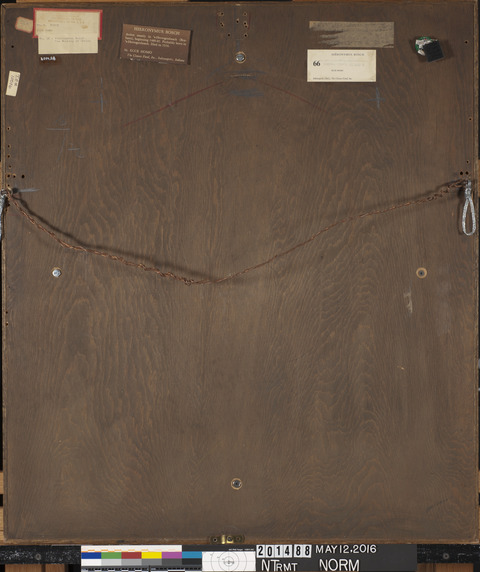
Frame Dimensions:
Outside frame dimensions:
80.5 × 71 × 7 cm
Sight size:
60.5 × 51.3 cm
Distinguishing Marks:
Front:
None
Back:
Item 1. Clowes paper collection label with printed red border, “THE CLOWES FUND, INCORPERATED/ FINE ARTS DEPARTMENT/ 3744 SPRING HOLLOW ROAD/ INDINAPOLIS, INDIANA, U.S.A./ No. 6. BOSCH/ ECCE HOMO” (tech. fig. 35).
Item 2. White paper label with typed writing, “No. 18 – Hieronymous Bosch/The Mocking of Christ” (tech. fig. 35).
Item 3. White paper label with red border, pencil handwriting crossed out, “5471” (tech. fig. 35).
Item 4. Indianapolis Museum of Art accession number in white paint, “2014.88” (tech. fig. 35).
Item 5. White paper label, handwriting in marker, “T.R. #/10006” (tech. fig. 35).
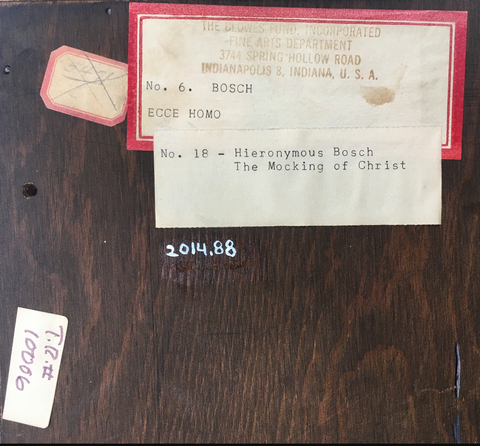
Item 6. Brown paper label, typed, “HIERONYMUS BOSCH/ Active mostly in ’s-Hertogenbosch (Brabant), beginning 1480-81. Probably born in ’s-Hertogenbosch. Died in 1516./ 56. ECCE HOMO/ The Clowes Fund, Inc., Indianapolis, Indiana” (tech. fig. 36)
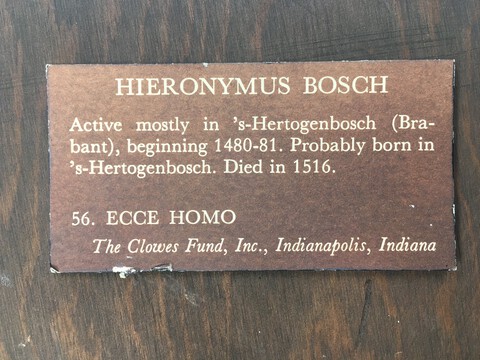
Item 7. White paper label, typed, “HIËRONYMUS BOSCH/ 66/ ECCE HOMO/ Indianapolis (Ind.), The Clowes Fund, Inc."; stamped upside down “DE EEUW DER VLAAMSE PRIMITIEVEN/ Groeningemuseum-Brugge-26-V1/11-1X-1960” (tech. fig. 37)
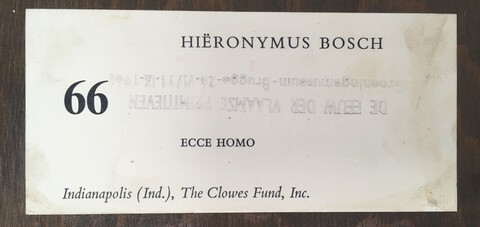
Description of Molding/Profile:
The frame is a carved wooden cassetta frame. There are carved wooden architectural elements (columns) left and right of sight window (tech. fig. 33). The back of the frame is a wooden panel creating a closed box when the painting is inset (tech. fig. 34).
Condition of Frame
The frame is in relatively good and stable condition.
Additional Notes:
Following the 2021 treatment, the painting is no longer displayed in this frame. It is now mounted on the wall without a frame.
Notes
-
Paul A.J. Spheeris, “Conservation Report on the Condition of the Clowes Collection,” 25 October 1971, Conservation Department Files, Indianapolis Museum of Art at Newfields. ↩︎
-
Martin Radecki, Clowes Collection condition assessment, undated (after October 1971), Conservation Department Files, Indianapolis Museum of Art at Newfields. ↩︎
-
The beeswax surface coating was identified using FTIR. Roxane Sperber, Clowes Collection treatment and analysis report CON2021.120, 3 April 2022, Conservation Department Files, Indianapolis Museum of Art at Newfields. ↩︎
-
Roxane Sperber, Clowes Collection treatment and analysis report CON2021.120 (3 April 2022), Conservation Department Files, Indianapolis Museum of Art at Newfields. ↩︎
-
Peter Klein, dendrochronological analysis report, C10006 (2014.88), 20 July 1994, Conservation Department Files, Indianapolis Museum of Art at Newfields. ↩︎
-
Paste vehicular and rich vehicular paint structures indicate paint films in which the ratio of pigment to medium is relatively balanced. Comparatively, rich vehicular paint contains a slightly higher medium content to paste vehicular paint, and the film appears slightly less thick—a heavily pigmented glaze. ↩︎
Additional Images
